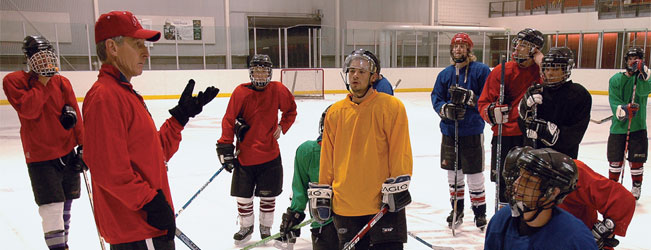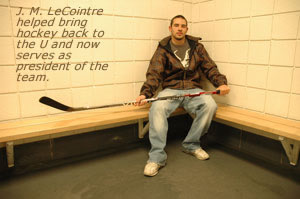
Sidelines

Back to the Ice Age
by John Youngren
This fall, as the University of Utah’s new semester was getting
under way and students were returning to campus, the U of U’s
hockey club was also gearing up, holding intensive tryouts, looking
for corporate sponsors, and trying to pull a schedule together.
Big deal? Absolutely. While having players try out for a club sport
at the U might not normally seem like anything special, it certainly
was in the case of hockey. For this year, after a forced hiatus that
extended to three years, the U finally reinstated its club hockey team,
which is scheduled to join BYU, Utah State, Weber State, and UVSC in
the Division II level of the American Collegiate Hockey Association
(ACHA).
The club, once known as the “Skatin’ Utes,” was flying
high following the 2002-03 season, which they finished with a 17-12-5
record. The team had played the season on the ice sheets at the Salt
Lake City Sports Complex on nearby Guardsman Way and was drawing impressive
support on campus and throughout the local hockey community.
The Skatin’ Utes were looking forward to even bolder success
the following season: The team had agreed to join the Division I-caliber
“Hockey West” league, getting the chance to play in a five-team
ACHA league, which was originally intended to include Colorado State,
Arizona State, Weber State, and the University of Arizona.
But it all blew up in March of 2003, just two months after the new
league was announced. That’s when a host of violations caught
up with the Utes, and the program was placed on a two-year suspension
by the U of U administration.
The move effectively disbanded the fledgling team at a crucial point
in its history and left the U without a hockey program despite great
interest around the state.
But by mid-September 2006, the new Utah hockey club had begun its 25-
to 35-game schedule, with a roster of players assembled from scratch
during the team’s tryouts and early practices. The team’s
first game was tough—they lost by a wince-inducing 18-3 in their
season-opener at Utah State. And depth was an issue—only 15 suited
up for the game. But the team has high hopes; the new Utes—avoiding
the tainted “Skatin’ Utes” moniker for now—are
a mix of talented high school graduates, amateur players, and existing
U students who may have hung up their skates for a few years but now
want back in the game (only one on the opening-night roster, Mike Wilcox,
had collegiate hockey-playing experience).
Putting all that together—not to mention dealing with new club
by-laws, a new constitution, a schedule, uniforms, and practice facilities,
to name just a few of the myriad details—has been a chore.
 And,
season-opener aside, winning actually isn’t even the top priority,
according to all those involved. Just being there is. “Even in
the worst-case scenario, at least we actually have a team,” says
U student J.M. LeCointre, who, along with fellow student and hockey
player Jason Petho, became the self-appointed leaders of an effort to
reinstate Utah’s hockey club. “We had a lot of friends who
were going elsewhere to play hockey. It was frustrating, because they
couldn’t play here [at the U].” And,
season-opener aside, winning actually isn’t even the top priority,
according to all those involved. Just being there is. “Even in
the worst-case scenario, at least we actually have a team,” says
U student J.M. LeCointre, who, along with fellow student and hockey
player Jason Petho, became the self-appointed leaders of an effort to
reinstate Utah’s hockey club. “We had a lot of friends who
were going elsewhere to play hockey. It was frustrating, because they
couldn’t play here [at the U].”
Nearly everyone involved with the current club avoids extensive comment
on the past problems of the Skatin’ Utes. According to various
reports at the time, the team had run up more than $20,000 in assorted
debts (hockey is one of the most expensive sports for an individual
athlete to participate in; LeCointre estimates that it’ll cost
around $1,500 for players to suit up this year). While much of that
money was later recouped by the team and its fundraising efforts, the
hockey club was still technically in debt when the U pulled the plug.
There were other violations that led to the Skatin’ Utes’
suspension: A player with a private pilot’s license flew his family’s
plane to a Utah road game—a violation that put the University
at risk because the team didn’t clear the travel plan with Campus
Recreation Services beforehand. An auto accident on a Colorado road
trip caused some $8,000 in damages to a van the team was using—also
charged to the club. And, there was at least one incident in which a
Utah player allegedly got into a physical altercation with a fan.
The infractions added up: The Skatin’ Utes were already on probation,
and campus officials had seen enough. It would be more than two years
before anyone got interested in doing much about hockey again.
“Our clubs are offered as a vehicle for students to not only
compete, but also to gain learning experience outside of the classroom,”
says Mary Bohlig, director of Campus Recreation Services, which oversees
the U’s 15 club sports, from cycling to water polo.
Student athletes, even club athletes, are reasonably held to a higher
standard than students less frequently in the public eye because they’re
representing the University and need to create a positive general impression
in all endeavors.
“Leadership, teamwork, time management, and making positive contributions
to the University community [are all expectations],” Bohlig says.
After the Skatin’ Utes’ suspension was lifted, LeCointre
and Petho got together and began a yearlong process of meeting with
U administrators, lawyers, Campus Recreation staff, and other officials
to discuss the possibility—remote at first, then more and more
realistic—of resuscitating U of U hockey.
“The suspension had expired,” Bohlig notes. “And
there was no hesitation to give the [hockey] club another chance. [But]
we wanted to make sure that all the people [associated] with the suspension
were [also] involved in setting parameters and meeting with the new
student leaders regarding past problems and expectations.”
That’s what took a little doing, LeCointre says. “A lot
of the response we got about bringing the program back had to do with
the [U of U officials’] trust in us; but the more they talked
to us, the more they began to realize what we’re trying to do
with this team, and they let us go ahead with it.” Easier said
than done.
Once the club was reinstated, much of its promotion—inviting
players to tryouts, generating sponsor interest, communicating practice
and meeting times—had to be done by word of mouth.
In a nod to the modern era, the new Utah hockey club has created a
Web page on the popular MySpace.com (Utah hockey is single and a Gemini,
if you’re wondering).
Further complicating things, no players involved with the suspended
Skatin’ Utes could play without being assessed a percentage of
the outstanding debt the disenfranchised club still owes.
“We did [give the new team] the opportunity to bring back former
players, but with some stipulations attached,” Bohlig explains.
But there hasn’t been a lot of interest from the past players,
says LeCointre. Even so, he’s been delighted to find initial interest—nearly
60 players expressed enthusiasm about a new opportunity to compete—and
support across campus as the Utah hockey club got down to business.
“I think that as this program grows and [becomes] a solid member
of the University community, you will see the interest grow,”
says Assistant Professor of Pharmaceutics and Anesthesiology Steven
Kern, who signed up as faculty advisor and helped the team recruit its
coach, Bob Wilkinson. “Our objective for the first season is to
have a second season. We will build this one step at a time.”
“People have been very supportive,” says LeCointre, who,
paradoxically, wasn’t able to play with the team initially because
of an injured shoulder, focusing instead on his newfound administrative
duties (basically serving as the team’s president). “All
we want to do is create a team that isn’t going to dissolve every
three years. Hopefully, nobody in the future will have to do what we
had to do to get it going again.”
Adds Bohlig, “We anticipate that the new group of students leading
the hockey club will do the right things to bring the team to the level
of conduct and competition that many of our other clubs present.”
So, the question is: Is hockey settled in for a long and happy life
at the U?
“That’s something to shoot for,” LeCointre says.
Presumably, no pun intended.
—John Youngren BA'88 works in advertising for Love Communications
in Salt Lake City and has written many previous articles for Continuum
Utah
Hockey MySpace Page
Return to Winter 2006-07 table of contents
|



